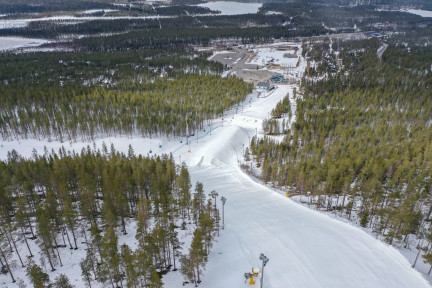
The 60-year legacy of snow certainty in Levi: From the World Cup to innovative snow storing
First stages of Levi’s skiing history
Levi’s 60-year history has shown significant growth and development, especially when it comes to skiing tourism. Skiing reached new levels in 1964 when Kittilä county acquired land on the Levi fell and built their first lift. Skiing operations grew throughout the years and in the beginning of the 2000s Levi saw notable investment, for example in lighting the skiing slopes and snow cannon systems, which in turn allowed for televised competitions. Snow storage in particular became an integral part of the infrastructure of Levi Ski Resort.
Hosting the World Cup and international visibility
Hosting the Alpine Skiing World Cup at Levi since 2004 has brought the ski resort international visibility and solidified its status as part of the FIS competition calendar. Levi has had the honour of starting the women’s and the men’s slalom season, which is a significant achievement for this ski resort. Usage of stored snow has been a crucial part of successful hosting of these events right at the beginning of the skiing season. Storing snow has also lengthened the skiing season at Levi from October right into the middle of May, bringing with it positive impact on the local tourism based economy.
Significance and development of snow storage at Levi
In 2016 snow storage was started at Levi to ensure the snow certainty of Levi World Cup and successful hosting of the competition. First snow storing measures were done at the Levi Black slope and the stored snow was spread onto the slope a few weeks before the competition. This new storage technique allowed for the successful organisation of the World Cup and added more snow storage on other slopes at Levi too. Front Slope got its snow cover in October, thus serving downhill skiers as well as international alpine skiing teams. Levi Ski Resort learned a lot from their first year of storing snow and continued to develop their systems, researching different covers for the snow for example to stop the snow from melting.
Environmental aspect of snow storage
Storing snow is first and foremost an environmentally friendly act, since using previous winters snow during the next winter season lessens the need for cannoned snow in the warmer conditions of early winter. By doing this, large amounts of water as well as energy is saved when the cannoning begins. In 2023, Levi Glacier has a record amount of stored snow - as much as 130 000 cubic metres. In addition to the snow at Glacier Slope, Levi Black stores 50 000 cubic metres of snow for the World Cup and 20 000 cubic metres for the first cross country skiing track.
Read more about snow storage: The secret of snow
Homage and expansions: The effects of snow storage at Levi
The expansion of Levi West in 2020 brought along with it more slope area as well as new lighting and snow cannoning capacity. Levi's long term investments into snow storage and other infrastructure was noted in 2023 when the Interski congress held at Levi was rewarded as the act of the year and the Finnish Ski Resort Association awarded Levi the prize of ski resort of the year.
Every year, more and more international teams come to open their skiing seasons at Levi in October, even men's teams that do not compete at Levi at all.
The legacy of storing snow at Levi: 60 years of growth and innovation
Levi’s 60-year history of growth is all due to collaboration, planning and sustainable development, with snow storage being an integral part of its development. Due to snow storage Levi has managed to open downhill skiing slopes earlier and hosted international level competitions which in turn has strengthened Levis position as a prominent cross-country and downhill skiing location nationally and internationally.
Read more about the 60 years of Levi’s history: The history of Levi at 60


